Menu
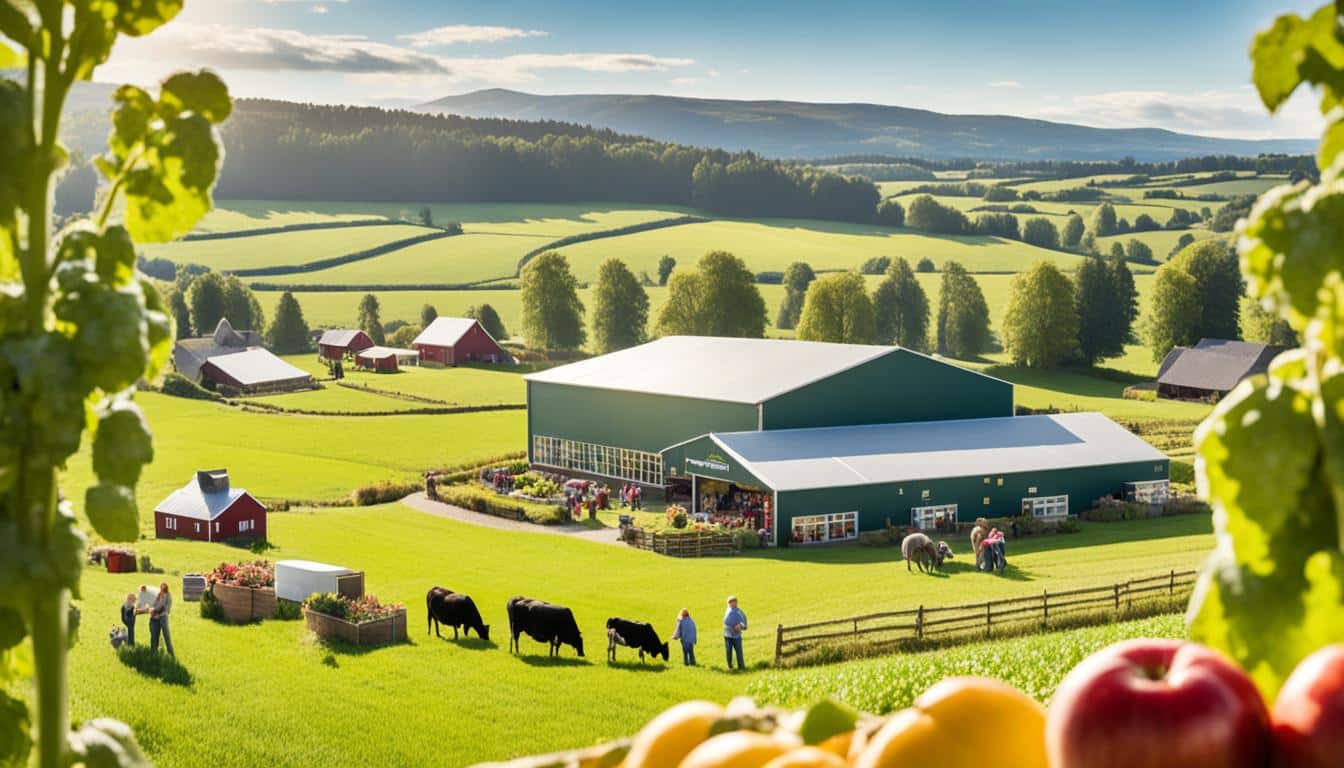
In 2019, agritourism in New Hampshire directly supported 9,454 jobs. It also created or helped 11,062 jobs. This shows how farm tourism boosts local economies. By 2019, it had generated $318.6 million in wages. Of this, $218 million went to those working directly in the sector.
The industry contributed $415.8 million to the state’s GDP. This led to a total output of $720.6 million. Additionally, agritourism in New Hampshire alone brought in $66.5 million in tax revenue. This tax income was split with $1.7 million going to local taxes, $25.3 million to state revenue, and $13.7 million to federal taxes. These figures highlight the sector’s significant impact on the economy. They underline its relevance in today’s market.
Agritourism mixes farming with tourism to offer fun and educational visits on real working farms. It lets tourists dive into rural life while helping farm businesses.
Agritourism is about activities on farms or agricultural lands. It’s when guests come to a farm for fun or learning, also helping farmers earn more.
Things like farm tours, picking your own fruits, and even helping on the farm are examples. Such activities help farms make more money and connect with the public.
Agritourism started in the early 1900s as city folks looked for breaks from urban life. Farm visits became popular quickly. In just a year, over 62 million people visited farms in America.
By 2008, agritourism was making between $800 million to $3 billion in the U.S. It began with simple things like buying directly from farms or taking educational tours. Later, it grew to include things like farm stays, winery tours, and more seasonal events, making it more popular.
Agritourism offers many different activities to suit everyone’s taste. Some activities are:
This wide range of activities makes the visitor’s experience better while boosting rural areas. From 2007 to 2012, more U.S. farms started doing agritourism – from 10,249 to 13,334. Their income went up too, from $546 million to $674 million.
Agritourism also builds connections between city and country life. It makes people value farming traditions and supports local food systems.
Agritourism has really taken off in the United States. It’s now a key part of the countryside’s economy. Since 2002, its earnings have more than tripled, drawing more interest. This boom shows that people enjoy connecting with farms and their activities.
From 2012 to 2017, the money made by agritourism grew from $704 million to nearly $950 million. This revenue became 5.6% of all farm earnings by 2017. It shows how important agritourism has become in farming.
| Year | Revenue (in millions) | Percentage of Farm-Related Income |
|---|---|---|
| 2002 | – | – |
| 2012 | $704 | – |
| 2017 | $950 | 5.6% |
Farms in busier areas seem to make more from agritourism. This is even though they might not always host as many activities. They do well with crops like grapes, nuts, fruits, and special livestock. These bring more people and, therefore, more money.
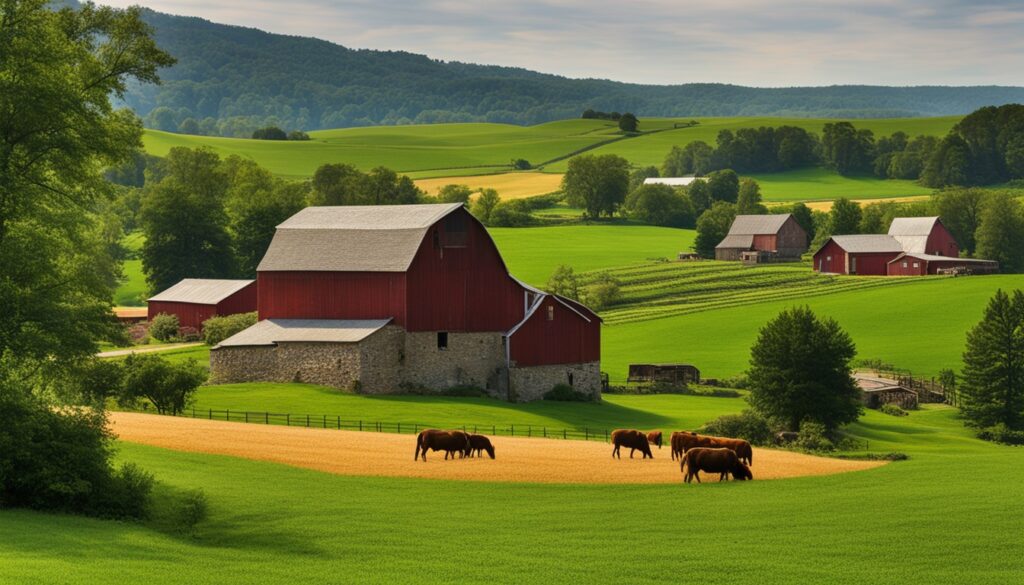
Around the US, agritourism levels vary a lot. Some places are big hits, thanks to being near to nature or cities. In western Texas and the intermountain West, activities like hunting and dude ranches draw a lot of visitors. These areas benefit from their easy-to-reach natural beauty and fun things to do.
But not every place does as well. The Midwest, for example, faces its own challenges with agritourism. This is because of the weather, culture, and the land’s appearance. Knowing these differences helps us guide agritourism’s growth more effectively.
Many successful farms in popular areas sell directly to people or shops. This direct selling often means they’re open to agritourism. It shows that a place’s entrepreneurial spirit and links to nature really matter.
Looking ahead, we need to study more on what works in agritourism. We must also find and remove barriers to its growth. This way, agritourism can keep benefiting rural areas well.
Agritourism significantly helps the rural economy grow. It mixes farm life with travel experiences. This mix opens up new markets and chances to explore. It boosts rural areas by adding incomes and supporting their growth.
Agritourism is key for farmers to make extra money. It’s a different kind of income from selling crops or raising animals. In Indiana, for example, their wine trails, started in 2004, bring in more money.
These farms benefit a lot when people visit, making Indiana a top travel spot with 58 million visitors a year. This helps smaller and mid-sized farms to keep up.
Agritourism opens up many jobs, which helps the local job market. This includes being a guide or working in a guest house. It helps both for full-time and seasonal work. This way, it makes rural areas more alive and strong.
The World Tourism Organization sees agritourism as big for jobs by 2020. Indiana’s case shows this, with tourism growing faster than in the whole country. This growth is not just about jobs. It also makes rural life and the economy better.
In short, agritourism is very important for rural places. It brings in more money and opens many job chances. This helps farmers and the whole local area. It keeps these places alive and growing.
Agritourism plays a big role in local economies. It adds value through direct sales and its impact on other businesses. Between 2002 and 2017, income from agritourism rose significantly. From 2012 to 2017, earnings went up from $704 million to nearly $950 million. This made in 5.6% of all farm income in 2017.
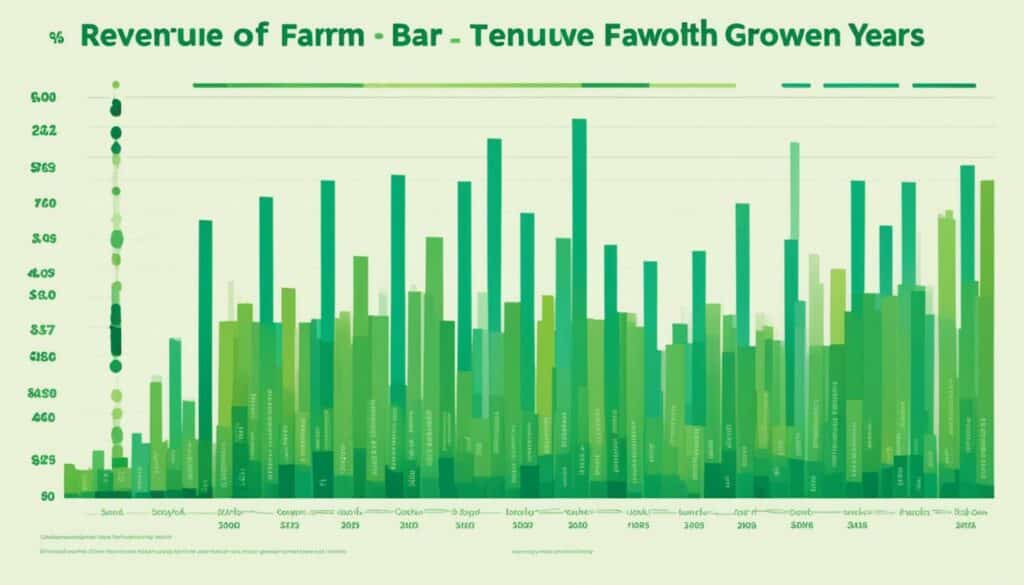
The money from agritourism isn’t just for the farms. It helps local shops, places to stay, and eating spots. This spending boosts the area’s overall economy and helps rural GDP. It shows how important agritourism is for the countryside.
For example:
Agritourism’s earnings spread out and help many local shops. This is good for growth and keeping those businesses going. Areas near natural beauty or outdoor fun see the most benefits. This helps build a strong rural economy.
The beneficial impact is multifaceted:
| Metric | Value |
|---|---|
| Total Direct Sales | $985 million |
| Value-added Sales | $572 million |
| Employment Impact | 11,000 jobs |
In conclusion, agritourism is vital for local businesses and rural GDP. Its growth suggests a bright future for the economy. It shows how important agritourism is for rural areas.
The world of agritourism is colourful, thanks to the work of women in agritourism and older farm operators. These groups really stand out. They often run big farms with lots of animals, like cattle or horses.
In 2017, the money from agritourism went up a lot, from $704 million to nearly $950 million. This jump shows how important being creative with farming is.
Women and older folk, especially those who make and sell food, love joining in on agritourism. They match well with certain farm jobs. This makes visitors happy and helps economic growth. Women in agritourism and older farmers are often in charge of farms with lots of animals. This brings in a good amount of money from agritourism.
All kinds of farms join in agritourism, each offering a special experience. Farms that grow grapes, fruits, nuts, and those with special animals do very well. They bring more people to the farm and offer fun things to do. This is good for agritourism and makes the farm more interesting to visitors.
| Demographic | Likelihood of Agritourism Involvement |
|---|---|
| Female Operators | High |
| Older Operators | High |
| Operators of Large Ranches (Cattle/Horses) | High |
| Operators of Specialty Crop/Livestock Farms | Moderate |
Places with lots of agritourism are well known and attract many people. They are good for growth that lasts. This is important as more farmers are thinking of trying agritourism. It helps keep small and medium farms going strong.
Many factors push the adoption of agritourism. Farms close to natural attractions and good marketing plans are key. The reputation of the region also matters a lot. Farms near cities and scenic routes make more money. This is because they are easier to reach and more people visit. Special marketing can make a farm stand out, bringing more visitors and more money.
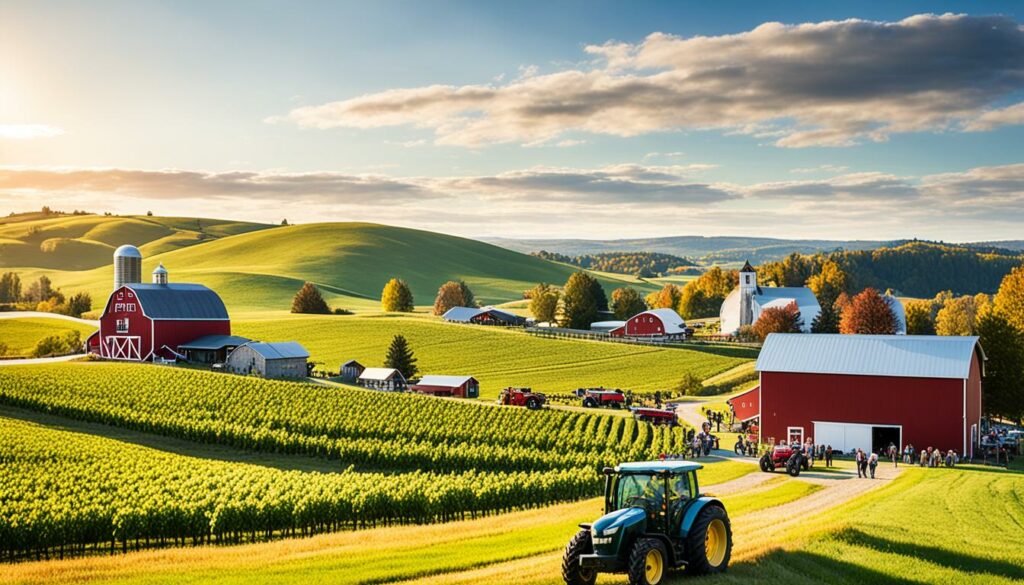
Farms near natural wonders draw in more visitors. This is good for tourists wanting outdoor fun. Places with lots of hiking or beautiful landscapes attract lots of people. This boosts the money farms make from agritourism.
Good marketing is essential for a farm to do well. Ads that show off a farm’s special features, like wine tours or fresh food, catch visitor’s eyes. Places with a great reputation in their region, like Napa Valley, are popular. Tourists look for these places for a real farm experience.
Agritourism revenue in the U.S. grew from $704 million in 2012 to nearly $950 million in 2017, adjusted for inflation.
Women, older people, and those with big farms and animals have found success in agritourism. Their farms’ good reputation and being near natural sites help them make more money. As agritourism grows, farms need strong marketing to show what makes them special. This is key to keeping up with this growing trend.
Agritourism is key to keeping our agricultural past alive. It mixes cultural farming with travel to save old farming ways and teach people. Keeping these farming traditions alive helps pass on knowledge and loves of farms through the years.
Agritourism is essential for saving local farms’ ways. It helps farms stay in business, especially those run by women or older people. These farms, focusing on things like grapes, fruits, special animals, and nuts, benefit a lot.
It’s not just about money, though. Agritourism also makes people value farming more. They learn about special farming methods and old kinds of animals. This means more than just another way to make money; it’s about keeping traditions alive.
The learning benefits of agritourism are huge. It lets people get their hands dirty and see where food comes from. With tours and workshops, folks see farming up close and learn a lot. Not just anyone can find out what farming is really like.
Between 2002 and 2017, the money from farm tourism grew a lot. It went from $704 million in 2012 to almost $950 million in 2017 (after adjusting for money changes). This shows how important farm tourism is, not just for money but also for teaching people. Places with more people and cool nature places see more visitors. Plus, farm tourism helps new businesses in the area.
In the end, agritourism is a win-win. It keeps our farming history and teaches visitors. By mixing travel with local farms, we cherish old traditions and create new memories. It’s good for the local economy and for everyone who loves to learn by doing.
Agritourism combines agriculture and tourism, boosting economic sustainability by mixing services. This mix enhances income and aids in rural development. Through successful stories, we see how agritourism can be a vital strategy for farmers.
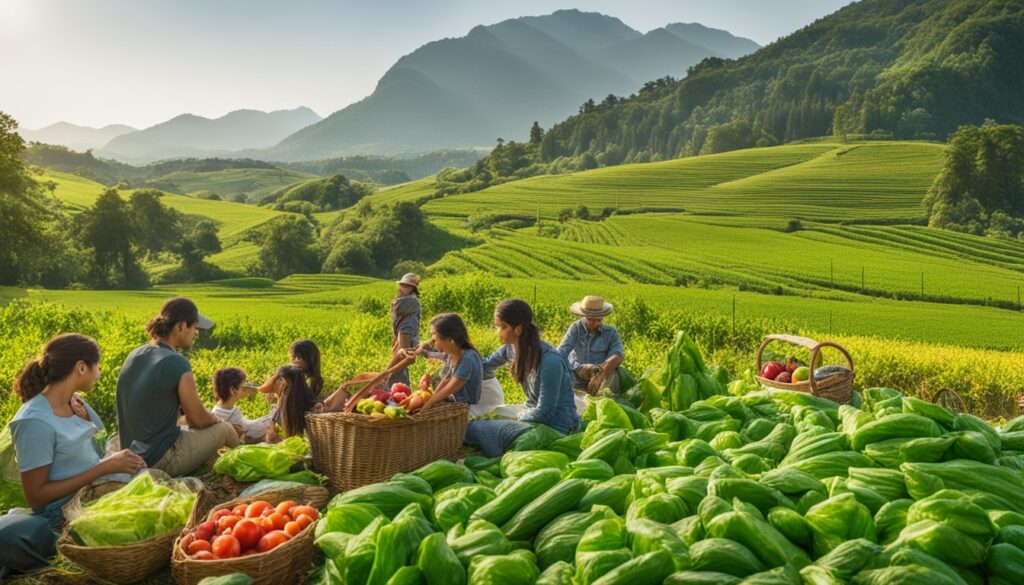
Exploring successful agritourism cases shows various strategies for survival. The EU’s policy since 1992 stands out, boosting farm income by supporting diversification. It aids farmers in less advantageous areas by offering compensatory payments.
In the U.S., the Willamette Valley sees around 4,000 farms in agritourism. Nearly half of these farms’ income comes from this venture, showing its value. With almost $1 billion in revenue and additional sales, it proves agritourism is a powerful economic booster.
Agritourism doesn’t just create immediate income; it ensures future financial stability too. It helps farmers earn from various sources, lessening their reliance on single outputs. Especially in the Willamette Valley, it protects farmland, keeping areas rural and supporting local communities.
About 11,000 jobs are linked to this sector in the Willamette Valley, both full and part time. The sector’s 3.7 to 13.7 million annual visitors back this, showing its long-lasting economic significance. These visits don’t just bring in money but help keep regional economies stable over time.
Some farms may not see instant gains from agritourism, but its diverse revenue benefits the sector overall. The EU’s support for this approach highlights its recognition of agritourism’s role in ensuring economic sustainability.
| Region | Farms Engaged in Agritourism | Annual Visitor Estimates | Revenue Generated | Employment Impact |
|---|---|---|---|---|
| Willamette Valley | ~4,000 | 3.7 million – 13.7 million | $985 million+ | ~11,000 jobs |
Success stories in agritourism point out both short and long-term financial rewards. They offer guidance on successful models, confirming agritourism’s value for farm and rural area economies.
Agritourism is key in creating jobs in the countryside. It offers both temporary jobs in farming and full-time work. With more and more places embracing agritourism, like those in Virginia with 1,400 sites, the need for a variety of skills is growing.
Agritourism jobs can be either for a season or last all year, both types are very important. There are positions just for the farming seasons, such as helping with the harvest. But there are also steady jobs like guiding tours or managing these sites. Virginia had about 22,151 people working full-time in agritourism in 2015. These jobs are not just good for individuals, they also help local economies.
Agritourism boosts community development in big ways. It helps the economy and the society to grow, making rural areas better places to live. In Virginia, the money visitors spent on farm visits in 2015 brought in $134.7 million in local taxes. This money goes back into making the community stronger and improves life quality. Jobs in agritourism not only help with local economy but also bring communities closer together.
| Metric | Virginia | Willamette Valley |
|---|---|---|
| Annual Visitors | 5,356 per establishment | 3.7M – 13.7M total visits |
| Total Jobs Supported | 22,151 FTE | 11,000 |
| Economic Activity | $2.2 billion | $985M direct and visitor spending |
Agritourism boosts farming incomes significantly. It has grown a lot from 2002 to 2017. For example, in 2017 it made nearly $950 million. This is a big deal because it makes up 5.6 percent of all money farmers earn.
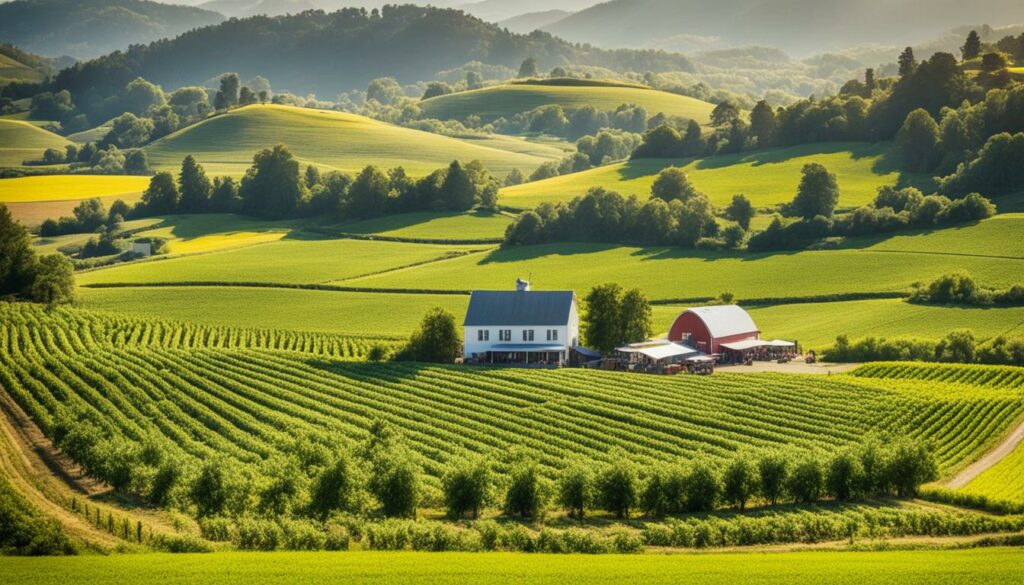
More women, older people, and those on big cattle ranches earn from agritourism. This shows how anyone can benefit. Farms near towns make more money from agritourism because they are close to more people.
Some farms do better than others in agritourism. Those with grapes, fruits, nuts, or special animals earn more. Also, places that offer activities like horse riding do well. Being close to nature helps too.
In places with more people, agritourism makes a lot more money. How keen people are to start new things there and the kind of jobs available also matter. In New Hampshire, agritourism made over 9,000 jobs in 2019.
It also made a lot of money for the workers and the state. Workers got $318.6 million, and it added $415.8 million to the state’s money (GDP). It paid $66.5 million in taxes, helping many people.
Figuring out what brings people to agritourism is key to understanding its growth. Things like culture, society, business, and the urge to create shape it. These factors make agritourism appealing to many.
The cultural influence agritourism is big for visitors. They want real farm life, like staying on farms or picking their own food. This draws a wide range of people, providing fun and learning.
The social impact agritourism also matters. It connects people by showing farm life through tours or petting zoos. This link helps communities and shares cultures.
The economic drivers farm tourism are important. From 2002 to 2017, agritourism money more than tripled, hitting nearly $950 million. Near cities or outdoor activities, farms do better.
Special goods like grapes or special livestock boost farms’ earnings. Farming owners are seeing the profit in this. More women and older folks are jumping into agritourism, especially if they sell food directly to people.
Counties with more business ideas and patents also do more agritourism. The future looks bright. Near cities and nature, agritourism could grow a lot. This growth helps small and mid-sized farms stay afloat. So, it’s good for rural areas too.
Agritourism boosts New Hampshire’s economy by creating jobs and income. It offers many job opportunities and helps the state earn significant tax revenue. This shows how important agritourism is for the area’s financial health.
In 2019, New Hampshire’s agritourism sector supported 9,454 direct jobs. It also indirectly created or supported 11,062 jobs. The earnings from this industry were substantial, with $318.6 million in total, $218 million going to those employed in it.
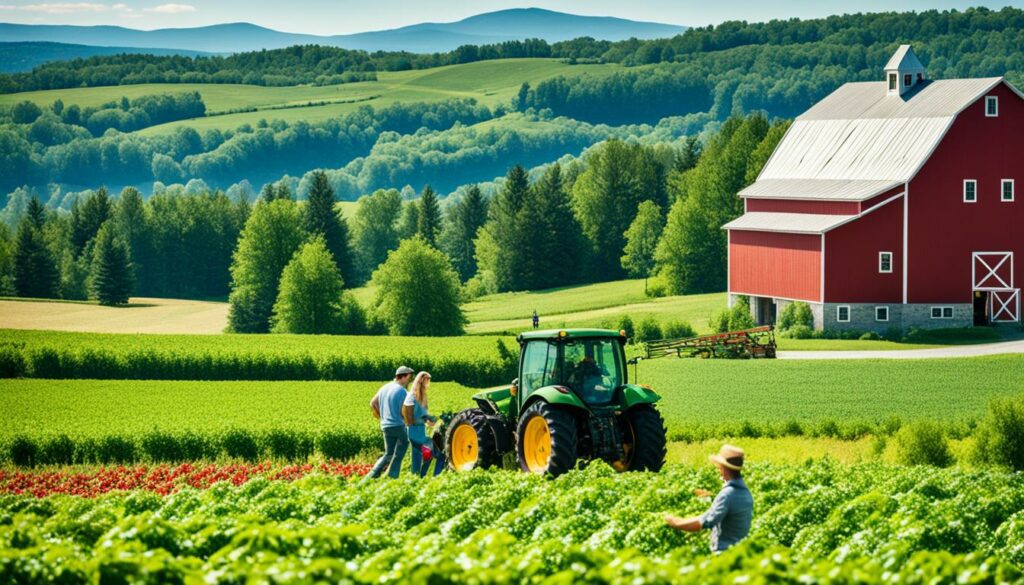
Agritourism added $415.8 million to New Hampshire’s GDP. This added up to a $720.6 million boost for the whole economy. These figures show the significant economic impact of agritourism in the state.
In 2019, New Hampshire’s agritourism sector contributed $66.5 million in tax revenue. This money was divided between local, state, and federal taxes as follows:
Over half of the state’s visitors took part in agritourism during their stay. On average, each visitor spent $171. This spending is a key part of agritourism’s role in the state’s economy.
Looking closely at job statistics from 2019, agritourism’s direct effects included 9,454 jobs and over $245 million in GDP. The sector also had significant indirect and induced effects, creating more jobs and economic value. This highlights the broad financial benefits of agritourism for New Hampshire.
Virginia has taken to agritourism, knowing how it boosts the economy and helps rural areas. Many places mix farming with tourism. It’s key to see the part and the good things agritourism does in Virginia.
The state code definition agritourism in Virginia explains what counts as agritourism. It includes activities on farms or ranches that let everyone see or enjoy farm life. This could mean farming, catching fish, making wine, or riding horses. The law helps this sector grow by encouraging such activities.
Agritourism is a big deal in Virginia’s economy. In 2015, it brought in about $2.2 billion. Of this, $1.5 billion was spent directly at agritourism spots. It also provided over 22,000 jobs that paid out around $839.1 million in wages.
When people travel over 50 miles to visit farms, it adds $1.0 billion locally. Counting money from markets, restaurants, and events off the farms, the total income is about $3.0 billion. This big number shows how agritourism can help rural areas.
It also helps with taxes, giving the state and local areas about $134.7 million. This is a big deal for the state’s budget.
Virginia is not just about money. Agritourism there also teaches people and keeps traditions alive. Many farms use eco-friendly ways and let visitors join in, which helps the community grow.
Virginia’s agritourism is booming, mainly because of the many places to visit. With 1,400 venues, over half open all year, and an average of 5,356 guests per spot, it shows how popular agritourism is. As Virginia’s farms continue to welcome visitors, they’re making a big difference in the countryside’s economy.
Agritourism has great potential but faces key challenges. These hurdles include dealing with laws, tackling issues in how to market, and making people aware. Overcoming these difficulties can help agritourism support rural areas better.
Issues with laws and regulations are big in agritourism. Different places have different rules, making it hard for operators to keep up. Liability is a major worry in the Northeast and Midwest. Meanwhile, the West deals more with zoning and permits. These barriers often slow down agritourism’s progress.
Getting the word out and reaching consumers are vital for growth. In the South, weak e-connectivity stands as a big challenge. It makes it tough for farmers to market their services online. Good internet helps expand information and marketing opportunities for farmers. Extension professionals are working to improve digital marketing strategies to counter this.
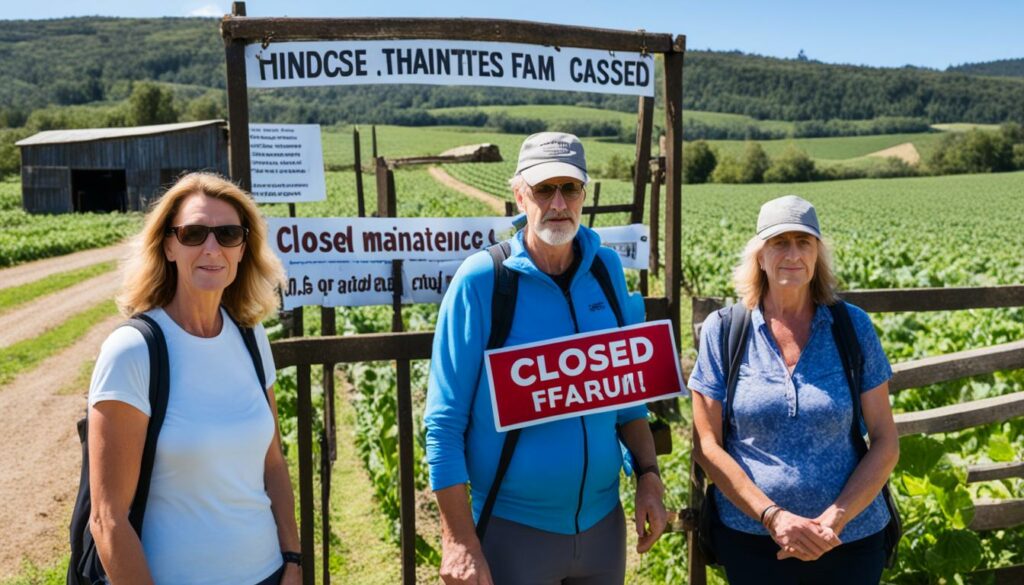
| Region | Key Challenges |
|---|---|
| Northeast | Liability |
| Midwest | Liability |
| South | E-Connectivity |
| West | Regulations, Zoning, Permitting |
Agritourism greatly boosts farm income, earning from $800 million to $3 billion each year in the US. Around $700 million of this comes right from agritourism. It’s clear this sector has a big impact. These challenges must be faced to keep growing and succeeding.
Agritourism is growing fast, opening up new chances for development. By making the most of new tech and working together, this field can attract more people. This not only boosts the economy but also makes agricultural areas more resilient.
New technologies are key for agritourism’s future. Things like virtual farm tours and apps for booking make visits more engaging. They also make it easier for people all over the world to enjoy farm tours.
It’s important for different groups to work together. This includes farmers, those in tourism, and local officials. Their teamwork helps create amazing visitor packages, which often include farm visits and great places to stay and eat.
Farms teaming up with local businesses can improve what they offer. For example, working with local wineries and breweries can lead to special tours. This attracts more visitors and keeps them coming back.
| Year | Agritourism Revenue (in $ millions) | Percentage Increase |
|---|---|---|
| 2002 | 704 | N/A |
| 2012 | 950 | 34.9% |
As more people take on new tech and work together, agritourism keeps getting better. This way, it supports farming and offers amazing experiences to everyone who visits.
Agritourism is very important for towns and villages. It brings special benefits to local people. These include closer community bonds and sharing different cultures. This helps make rural areas more lively.
Agritourism boosts the money in local towns and villages. It helps nearby shops by making more people want their goods and services. This has caused more jobs to be made and the economy to stay strong.
In the U.S., agritourism’s earnings grew to nearly $950 million, three times more than before. In 2017, it made up 5.6% of the money coming from farms. This extra money supports local living and brings many pluses to the community.
More than money, agritourism helps neighbourhoods come together. By sharing in farm life and events, it creates bonds. People from cities get to know rural life through agritourism. This leads to a rich cultural exchange for all.
Urban areas near farms see the biggest gain from agritourism. They let city folk experience the countryside. All these moments help in keeping old traditions alive.
| Aspect | Impact |
|---|---|
| Revenue Growth | Agritourism revenue tripled from 2002 to 2017 |
| Community Ties | Strengthens rural identity and community bonds |
| Cultural Exchange | Encourages interaction between visitors and locals |
| Employment | Creates jobs and economic stability for locals |
Agritourism can make a place stand out by highlighting local crops and traditions in festivals. This way, communities become more attractive to visitors and businesses. The steady growth of agritourism is key for building a lasting and happy community life.
The agritourism sector in Virginia shows huge promise. It boosts the state’s economy significantly. With over 1,400 sites, it impacts local GDP a lot. This shows how big its role is in the state’s economy.
Each site welcomes about 5,356 visitors yearly. These visitors spend a lot of money, hitting $1.5 billion in 2015. This led to a huge economic activity of $2.2 billion. It’s important to note that 17% of this money was spent directly at the agritourism sites.
Virginia’s agritourism is also big for jobs and earnings. It supports over 22,000 full-time jobs and adds to over $800 million in wages. Also, it adds a lot to Virginia’s GDP, around $1.2 billion.
In 2015, it also brought in about $134.7 million in taxes. Tourists who came from over 50 miles away spent nearly $1.0 billion. When you add money from off-farm markets, restaurants, and festivals, the sector’s impact jumps by 40%. This makes the overall economic activity $3.0 billion.
| Metric | Value |
|---|---|
| Total Establishments | 1,400 |
| Annual Visitors per Establishment | 5,356 |
| Visitor Spending | $1.5 billion |
| Total Economic Activity | $2.2 billion |
| Contribution to GDP | $1.2 billion |
| Full-Time Jobs Supported | 22,151 |
| Wage and Salary Income | $839.1 million |
| State and Local Tax Revenues | $134.7 million |
| Impact from Long-Distance Tourists | $1.0 billion |
| Total Economic Activity (Including Off-Farm Revenues) | $3.0 billion |
The data clearly shows agritourism’s vital economic role. It supports rural growth and preserves culture. Its ability to keep growing and adapting is key to its success. This makes agritourism critical for the rural economy’s future.
The Meta title quickly tells us what the article is about: “The Economic Impact of Agritourism.” It focuses on how agritourism boosts rural economies and keeps farming alive. This title draws in readers keen on learning about agritourism’s positive effects on rural life.
The Meta description gives a short and sweet summary. It talks about how agritourism helps farmers earn more and creates jobs in the countryside. It also mentions the challenges like seasonal work and rules, showing the full picture of agritourism’s role in bringing life back to rural areas.
Agritourism’s growth, from $5.7 billion in 2018 to a forecast of $12.9 billion by 2025, is huge. 42 studies talk about the importance of using local resources to make agritourism sustainable. This highlights agritourism’s part in fighting poverty and supporting eco-friendly food practices.
In closing, the Meta title and description introduce us to agritourism’s big role in the economy. They’re designed to inform and interest both readers and experts. This mix of facts and appeal aims to spark interest in the sector’s impact on countryside growth.
Agritourism mixes farm activities with tourism. It lets visitors enjoy fun or learning activities on real farms. This can include guided tours, picking fresh fruit, and eating meals made from farm goods.
It started with just farm visits. Now, it offers so much more, like visiting wineries and staying in cosy farmhouses. These changes have made visiting farms more fun and educational.
You can do lots on an agritourism visit. Think about touring farms, picking your own fruit, and getting close to farm animals. There are also fun activities like navigating through corn mazes, tasting local wines, and joining in with festivals. And of course, eating meals straight from the farm is part of the fun.
From 2002 to 2017, the money made from agritourism in the US tripled. It’s really popular in places near beautiful natural sights or big cities. However, it hasn’t spread as much in the Midwest part of the US.
Agritourism helps farmers earn more money and provides jobs. It also boosts local businesses. All this helps the whole countryside grow and develop.
When people visit agritourism places, they spend money on things like places to stay and food. This helps these local businesses grow and supports the area’s economy.
Usually, women and older people run agritourism farms, especially if the farms are big. These farms might focus on growing fruit, nuts, or having special types of livestock. So, different kinds of farms can join in on agritourism.
Being close to nature and having interesting things to do bring people to agritourism places. Also, good marketing and having a well-known farm name are important.
It teaches visitors about farming and where their food comes from. This learning keeps old farming ways alive and shares the story of the land.
It helps farmers have a steady income, easing the ups and downs of farming life. This kind of tourism also adds to the region’s economy in many different ways.
Agritourism makes both temporary and full-time jobs. This helps build up the local community and supports the area’s economy in the long run.
People get into agritourism because they love their culture and hope to make a business. This is true for both the farm owners and the people who visit.
In New Hampshire, agritourism makes thousands of jobs and brings in a lot of money. It also creates a good income and business for the local area.
In Virginia, agritourism is a big part of the economy. It adds a lot to the state’s wealth and makes jobs. Plus, it helps the area by bringing in tax money.
Agritourism has some tough parts, like laws and not enough people knowing about it. These things can make it hard for agritourism to grow and get better.
New technology and working together can make visiting farms better. This can help keep farmers earning well and make it more fun for visitors.
Agritourism brings people together and lets them share their culture. It also helps people from different places to get to know each other. This all helps the community to grow in a good way.